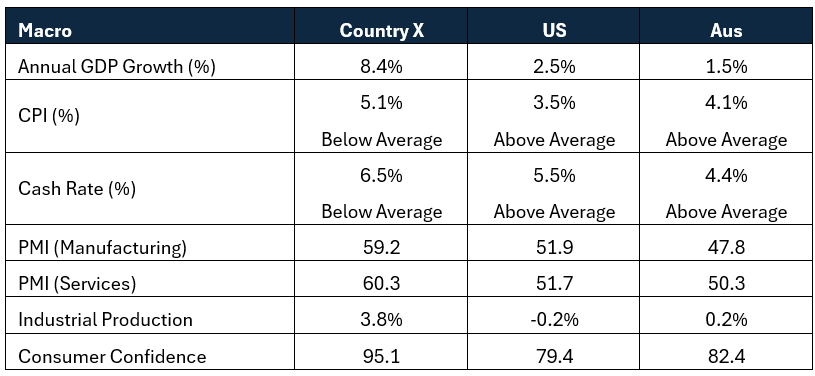A high quality asset at a cheap price
Consumers aiming to buy a product will consider quality and assess its value based on their perception of that quality. Similarly, a wise investment strategy focuses on identifying high-quality assets capable of sustained growth, without paying a high cost. Ideally, everyone would adopt a single investment approach: acquiring quality at an affordable price.
In Q1CY24, identifying such assets has become increasingly challenging. Valuations have soared for assets with robust or consistent growth profiles. Conversely, value seems more evident in cyclical industries and companies, with the expectation that they will perform well.
GREAT MACRO BACKDROP
An ideal investment is bolstered by a favorable macroeconomic environment, strong economic growth, and a stable inflation and currency regime. This article will discuss Country X, an investment region that fits the desired profile. Over the past 30 years, the region's GDP growth has averaged between 6.5-7.0%, with projections to maintain this rate for the remainder of the decade. Country X also enjoys structurally lower inflation, currently around 5%, compared to an average of 7.6% over the last 40 years. The cost of capital is lower than it has been historically, contrasting sharply with most other regions. Key economic indicators for Country X, such as PMIs, Industrial Production, and Consumer Confidence, are significantly higher than those in regions like the US and Australia.

ROBUST CORPORATE ENVIRONMENT
In addition to macroeconomic indicators, the corporate landscape is crucial for investment decisions as compelling microeconomic factors are equally important. Corporate leverage can lead to increased revenues and profits. Nonetheless, assessing the quality of an investment requires consideration of healthy profit margins and debt levels. In contrast to many regions where leverage drives growth, companies in Country X currently boast a low debt-to-equity ratio, the lowest in the past 25 years. Their cash flows and profit margins are strong, contributing to solid balance sheets. Moreover, the weighted average cost of capital remains unchanged, even with the global uptick in interest rates.

STABLE, HIGH-GROWTH EARNINGS
Finally, it is crucial to identify the type of earnings stream an asset generates, along with its growth rate and the volatility of that growth. Quality investors look for certainty in earnings and growth rates that are superior to the broader investment market. Comparing Country X with the equity markets of the US and Australia, we observe a clear advantage in these aspects.

Observing the cumulative returns and earnings across all three regions since the year 2000, it is evident that Country X's equity market performance has multiplied 25 times, compared to 6 times for both the US and Australia. Earnings per share (EPS) compounding in Country X has resulted in a ninefold increase in earnings, whereas the US has seen a fourfold increase, with Australia trailing due to its emphasis on dividend payouts. The power of compounding growth is demonstrated below:

Overall, Country X has successfully met our comparative framework criteria, exhibiting a 'goldilocks' macroeconomic environment, a robust corporate sector, and consistent earnings growth with manageable volatility. Country X is, in fact, India, and our analysis pertains to the Indian equity market.
HANG ON, INDIAN EQUITIES ARENT CHEAP!
India's equity market may be thriving, yet it remains costly when assessed through traditional P/E or P/B metrics on a one-year forward basis. Considering the emphasis on acquiring quality assets at an economical price, the final aspect of the investment framework examines the most efficient implementation method.
To uncover value in a high-quality growth market, investors need to examine shifting profit pools and areas of incremental growth that may be mispriced. Such insights are often not apparent in the benchmark heavyweights or large-cap stocks of any market. With over 6,000 listed companies, the vast opportunity set is conducive to primary research and active management in order to discover growth opportunities that are under-invested or not widely known. The extensive range of investable companies in India offer prospects for active managers who possess an in-depth knowledge of the local business environment, including the mindset of founders, local regulations, politics, and macroeconomic factors. Utilising locally based active managers can provide access to stock coverage beyond the highly liquid and frequently over-owned top 100 companies by market capitalisation.
Investing in India's growth narrative requires a long-term horizon, ideally over 10 years, to benefit from compounding and low-volatility earnings. Achieving a prudent valuation may necessitate a trade-off in liquidity, favoring greater exposure to small and mid-cap stocks, rather than prioritising liquidity solely for exit purposes.
5 topics

